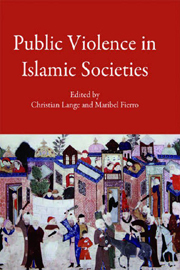 Public Violence in Islamic Societies
Public Violence in Islamic Societies Book contents
- Frontmatter
- Contents
- List of abbreviations
- Acknowledgements
- Introduction: Spatial, ritual and representational aspects of public violence in Islamic societies (7th–19th centuries ce)
- PART I Public violence and the construction of the public sphere
- 1 The case of Jacd b. Dirham and the punishment of ‘heretics’ in the early caliphate
- 2 Qāḍīs and the political use of the maẓālim jurisdiction under the cAbbāsids
- 3 From revolutionary violence to state violence: the Fāṭimids (297–567/909–1171)
- 4 Actions speak louder than words: reactions to lampoons and abusive poetry in medieval Arabic society
- PART II Ritual dimensions of violence
- PART III Representations of public violence
- Index
4 - Actions speak louder than words: reactions to lampoons and abusive poetry in medieval Arabic society
from PART I - Public violence and the construction of the public sphere
Published online by Cambridge University Press: 12 September 2012
- Frontmatter
- Contents
- List of abbreviations
- Acknowledgements
- Introduction: Spatial, ritual and representational aspects of public violence in Islamic societies (7th–19th centuries ce)
- PART I Public violence and the construction of the public sphere
- 1 The case of Jacd b. Dirham and the punishment of ‘heretics’ in the early caliphate
- 2 Qāḍīs and the political use of the maẓālim jurisdiction under the cAbbāsids
- 3 From revolutionary violence to state violence: the Fāṭimids (297–567/909–1171)
- 4 Actions speak louder than words: reactions to lampoons and abusive poetry in medieval Arabic society
- PART II Ritual dimensions of violence
- PART III Representations of public violence
- Index
Summary
Invective poetry as violence
The genre of hijaɔ, ‘satire’, ‘lampoon’, or ‘invective poetry’, was a cultural phenomenon very characteristic of pre-Islamic Arabian society. It had a special significance in the context of tribal conflicts and rivalry, and was by no means considered sinful or reprehensible per se even though recognized to be a form of aggressive challenge. From the time of the great Islamic conquests urbanization, detribalization and the increasing dominance of Islamic values, emphasizing the brotherhood of all Muslims and condemning unnecessary conflict as well as malevolence and slander gradually modified popular attitudes to hijaɔ to some extent. Popular assessments of the phenomenon palpably shifted towards disapproval. However, that vague disapproval did not result in the emergence of clear-cut norms, a set of straightforward rules, for the proper manner of reacting to a challenge of hijaɔ. As we shall see, a myriad possibilities of response were available to the offended person, and deciding the eventual course of action or inaction involved considerations of audience, publicity and secrecy, honour, generally accepted norms, political realities, and social circumstances. Surely, personal temper also played a role. Reactions to hijaɔ apparently ranged from extremely violent retaliation to deliberate inaction; and both extremes of behaviour might be either approved or disapproved of by the public, depending on the circumstances and the various interpretations of the antagonists' motives.
- Type
- Chapter
- Information
- Public Violence in Islamic SocietiesPower, Discipline, and the Construction of the Public Sphere, 7th-19th Centuries CE, pp. 87 - 116Publisher: Edinburgh University PressPrint publication year: 2009


